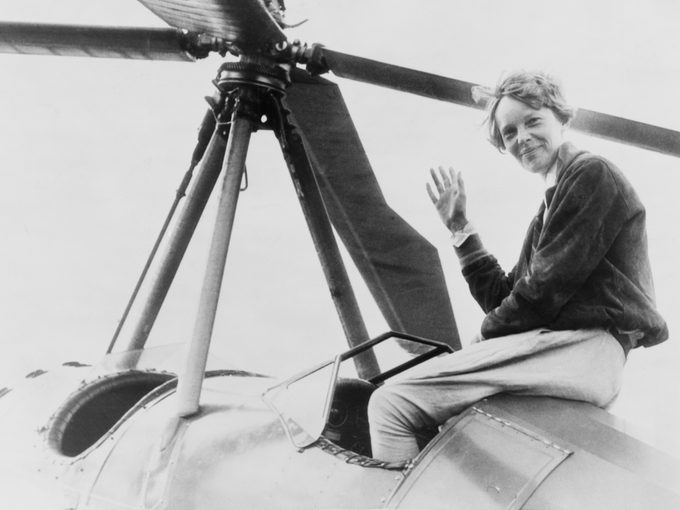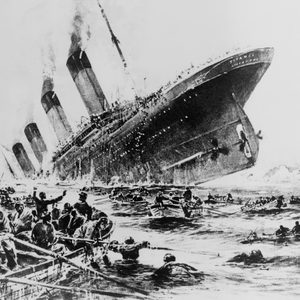These Mysterious Aircraft Disappearances Will Keep You Up at Night
From Amelia Earhart's final flight to a plane that vanished over the infamous Bermuda Triangle, these aviation mysteries continue to baffle historians and Internet sleuths alike.

The fate of Amelia Earhart
The disappearance of Amelia Earhart continues to be one of the most talked-about missing plane mysteries in history. On July 2, 1937, the world-famous American aviator and her partner, Fred Noonan, disappeared in her Lockheed Model 10-E Electra. The pair took off from Lae, Papua New Guinea, with the goal of flying around the world—unfortunately, they lost contact somewhere over the Pacific Ocean and were declared missing the same day. Ships and aircraft from the U.S. Navy and Coast Guard later scoured more than 640,000 square kilometres of ocean, but Earhart and Noonan were nowhere to be found. Official reports conclude they ran out of fuel, crashed into the Pacific and drowned.
The vanishing squadron
What began as a routine training flight turned into one of history’s most infamous missing plane mysteries. On December 5, 1945, five TBM Avenger Torpedo bombers—collectively known as Flight 19—departed the Naval Air Station Fort Lauderdale carrying 14 airmen. During the mission, the pilots began speaking incoherently, compasses started to malfunction and an eerie buzz of static replaced radio communications. To add to the mystery, the Flight 19 bombers were flying over the Bermuda Triangle at the time of their last signal. After learning that Flight 19 was completely lost, two Martin PBM Mariner flying boats were dispatched—20 minutes into the search, one of the Mariners vanished as well. To this day, the exact cause of Flight 19’s disappearance is unknown.
The mystery of the Bermuda Triangle
The Star Tiger also seems to have fallen prey to the Bermuda Triangle’s alleged curse. On January 30, 1948, the aircraft, a BSSA Avro Tudor IV travelling from the Azores to Bermuda, vanished while flying over the Atlantic Ocean. Twenty-five passengers and six crew members were on board. The last communication between the Star Tiger and Bermuda’s airport tower was recorded at 3 a.m.—later calls to the Star Tiger went unanswered. The U.S. Air Force commissioned 26 aircrafts for a five-day rescue mission, but the search was in vain.
A pilot’s enigmatic final word
On August 2, 1947, a BSSA Avro Lancastrian airliner—Star Dust—carrying 11 passengers and crew was on its way to Santiago, Chile, from Buenos Aires. A routine Morse code message went out at 5:41 p.m., signalling the aircraft’s expected arrival in Santiago. Later, however, the airport received a message that matched no known Morse code abbreviations: S-T-E-N-D-E-C. It was the last communication received from the Star Dust, which never reached its destination. A massive search for the wreckage and possible survivors proved fruitless. Fifty-three years later, climbers on Mount Tupungato in Argentina discovered the remains of a Rolls Royce engine, fuselage and strips of bleached clothing. This sparked an expedition to search the mountain, where debris and human remains were finally found. The mysterious meaning behind S-T-E-N-D-E-C has never been solved.
A mid-flight explosion?
On March 16, 1962, a Lockheed L1049H Super Constellation prop liner carrying 93 U.S. soldiers, 11 crew members and three South Vietnamese passengers disappeared into thin air. The flight, which was heading to Ho Chi Minh City from California, stopped to refuel in Guam—but disappeared 80 minutes after takeoff. The aftermath? One of the largest air and sea searches in the history of the Pacific, covering 220,000 square kilometres over eight days. Unfortunately, neither the aircraft nor any bodies were found or recovered. There’s some speculation that the aircraft may have exploded mid-flight since a bright light was seen in the sky after its last radio contact, but this has never been confirmed.

The costliest search in aviation history
One of the most famous missing plane mysteries is Malaysia Airlines Flight 370. On March 8, 2014, the plane, en route to Beijing from Kuala Lumpur with 227 passengers and 12 crew members on board, disappeared an hour after takeoff. Search efforts began in the South China Sea, with 34 ships and 28 aircraft from seven countries participating. Analysis of radar and satellite data revealed that after its final message around 1:00 a.m., the plane veered dramatically off-course before cruising on autopilot for hours. It’s now believed that the plane flew until it ran out of fuel and plunged into the Indian Ocean—far from initial search efforts. Two years after the disappearance, debris from the aircraft was discovered off the coast of South Africa and Mauritius, but conspiracy theories abound.
The disappearing Douglas DC-4
On July 21, 1951, a Canadian Pacific Air Lines Douglas DC-4 took off from Vancouver to Tokyo with 37 people on board, including Army and Air Force personnel. On the way to a stopover in Anchorage, Alaska, however, the plane faced heavy rain and icy conditions, causing it to veer from its flight path. A rescue operation was launched several hours later when the Douglas DC-4 failed to arrive. After a three-month search by both Canadian and American aircrafts, the search was called off on October 31, 1951. To this day, no trace of the aircraft has been found.
Next, find out more about Canada’s most notorious cold cases.






